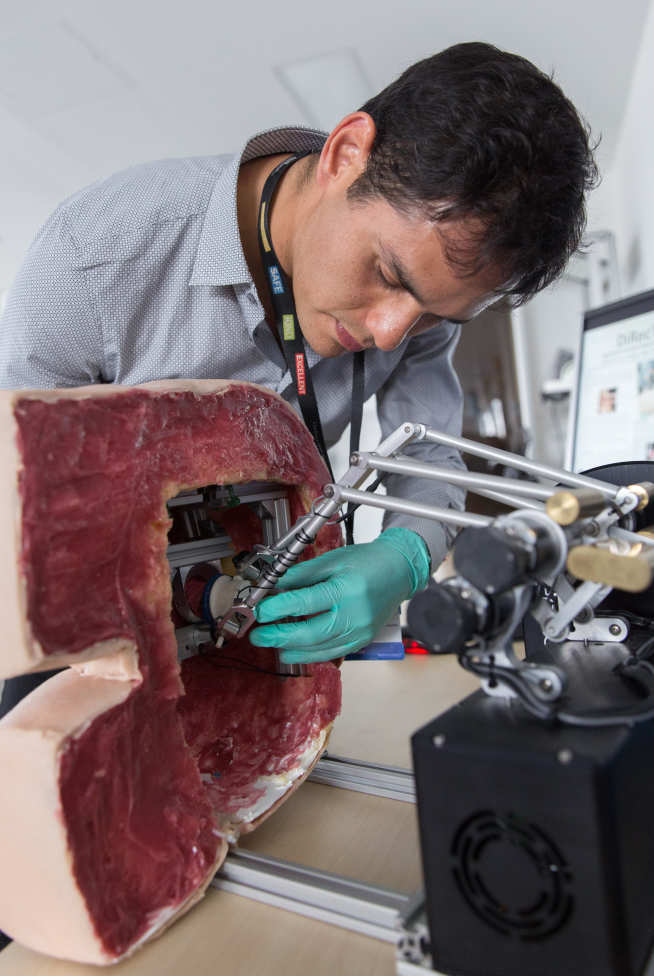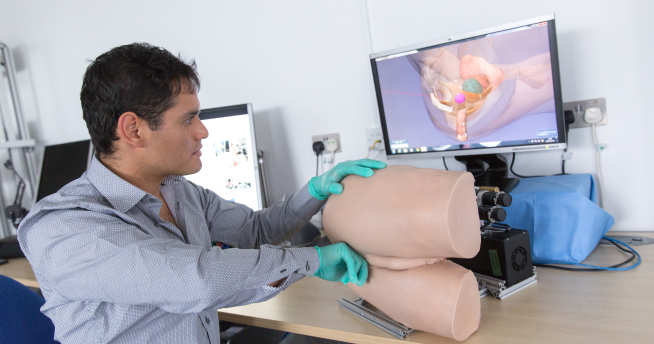Funded by EPSRC Pathways to Impact Awards 2015-2016
Project summary

Digital Rectal Examination (DRE) is important for the diagnosis of anorectal abnormalities in primary and secondary care and plays a critical role in the early detection of rectal and prostate cancers. DRE is also usually the first test done to diagnose the highly prevalent Benign Prostate Hyperplasia (BPH – enlargement of the prostate with age). Bowel cancer screening guidelines recommend DRE as an initial screening test in all patients with recent rectal bleeding or other suspicious symptoms.
DRE is routinely performed by GPs, Urologists, Colorectal Surgeons / Nurses and Nurse Practitioners. It requires the clinician to insert a lubricated gloved finger into the back passage to detect or exclude rectal disease, BPH and other prostatic abnormalities (men) and cervical pathology (women). DRE is uniquely challenging to learn and teach, since visual cues are minimal (conducted almost entirely by feel). Novices must use their finger to build up a mental representation of the anatomy and learn to recognise normality and disease. Crucially, instructors are unable to feel what novices are feeling, so cannot provide effective guidance or assess performance.
Simulation offers obvious benefits, allowing learners to practise repeatedly and to build up skills in safety. Whilst there exist a variety of benchtop models, they have major deficiencies: 1) the instructor cannot ‘show a novice how to feel’, or record and assess their progress; 2) the wide range of normal and abnormal findings is not adequately reproduced; 3) currently available simulated tissues do not feel authentic.
Project aims

The aim of this EPSRC-funded current phase of the ongoing project is to develop a commercial prototype of DiRECTS. This will include a redesign of the prototype haptic device, finger thimble and active sphincter mechanism, new modular software structure, improved prosthetic model with realistic surrounding external tissues, Graphical User Interface, content and performance feedback.
Progress and outputs
Over the last five years, our group has conducted several research strands that include the systematic mapping of the steps of DRE , real-time visualisation and analysis of trajectories and pressures during a DRE, haptics modelling for DRE and development of DiRECTS, a novel Digital Rectal Examination Haptics Training System. DiRECTS supports patient-specific DRE on normal and pathological anatomy and is capable of providing real-time feedback to the trainee and trainer. Haptics modelling and deformation modelling algorithms have been implemented on patient-specific anatomy to allow trainees to palpate and diagnose healthy and pathological anatomy.
- Alejandro Granados, Niels Hald, Aimee Di Marco, Shahla Ahmed, Naomi Low-Beer, Jenny Higham, Roger Kneebone, Fernando Bello. Real-Time Visualisation and Analysis of Internal Examinations – Seeing the Unseen. MICCAI 2014;8673:617-625. (Chapter 3)
- Alejandro Granados, Erik Mayer, Christine Norton, David Ellis, Mohammad Mobasheri, Naomi Low-Beer, Jenny Higham, Roger Kneebone, Fernando Bello. Haptics Modelling for Digital Rectal Examinations. Biomedical Simulation. 6th International Symposium, ISBMS 2014; 40-49. (Chapter 7)
-
A. Granados, L. Maréchal, A. Barrow, G. Petrou, C. Norton, F. Bello, Relax and Tighten – A Haptics-based Approach to Simulate Sphincter Tone Assessment, Asia Haptics 2016, Chiba, Japan, Nov. 2016.
- Arthur Loisillier, Alejandro Granados, Alastair Barrow, Fernando Bello. Thimble End Effector for Palpation Skills Training. Eurohaptics 2016
- L. Maréchal, A. Granados, L. Ethapemi, S. Qiu, C. Kontovounisios, C. Norton, F. Bello, Modelling of Anal Sphincter Tone based on Pneumatic and Servomotor Mechanisms, IEEE World Haptics 2017, Fürstenfeldbruck (Munich), Germany, Jun. 2017.
- Haptics-based simulator prototype for DRE within a clinical setting to GP educators and public health officers as part of the “Collaborative Clinical Education: Using simulation tools to address learning and service needs in Primary Care and Public Health” workshop during the Primary Care and Public Health Presentation at Charing Cross Hospital. London (2016).
- Haptics-based simulator prototype for DRE to GP educators as part of the “Educational Technology and Innovations to Training and Patient Care using Simulation” workshop during the HENWL Primary Care Educator Conference at Westminster Hall. London (2015).
- The Palpation Index interactive station consisting of a haptics-based simulator prototype for DRE and Online & Retrospective feedback toolto prospective medical students as part of the Inspirational Lecture Series at theLee Kong Chian School of Medicine. Singapore (2015).
- Haptics-based simulator prototype for DRE to the medical education community as part of the “Collaborative Clinical Education” workshop during the Simulation: Is a New Approach Needed? HENWL Conference at the Macmillan, Senate House, Russell Square. London (2014).
- Haptics-based simulator prototype for DRE to clinical Multi-Disciplinary Teams (MDTs) and administration staff during the HENWL Primary Care and Community Forum at the Hotel Russell. London (2014).
- In Search of the third dimension interactive station consisting of a 3D visualisation of anatomical variability tool and a tool for creating 3D models from MRI images at the Royal Institution as part of the lecture series ‘Teaching your eyes to feel’. London (2014).
- The Palpation Index interactive station consisting of a haptics-based simulator prototype for DRE at the Royal Institution as part of the lecture series ‘Teaching your fingers to see’. London (2013).
- Haptics-based palpation of different types of prostate duringSTEM Haptics workshopfor talented and gifted kids (Exscitec). London (2011, 2012, 2013).
- Haptics-enabled Palpation Racing Game at the Big Bang Festival. London (2012). (Appendix E)
Project team
Dr Alejandro Granados Martinez
/prod01/channel_3/media/migration/faculty-of-medicine/Alejandro--tojpeg_1470391558155_x4-1.jpg)
Dr Alejandro Granados Martinez
Project lead